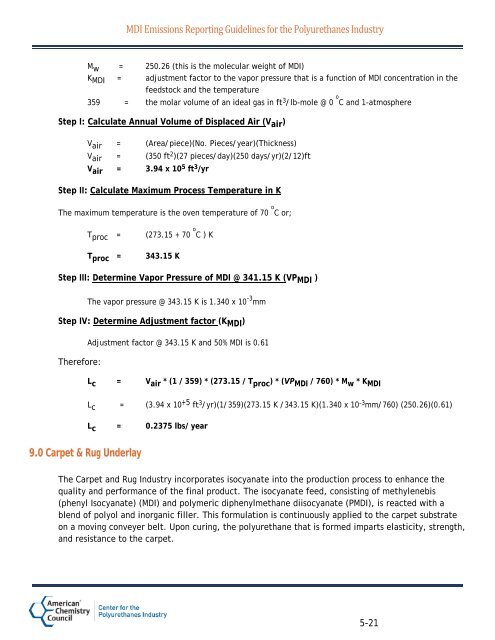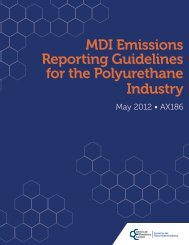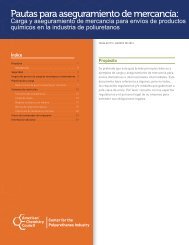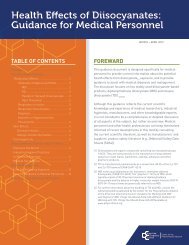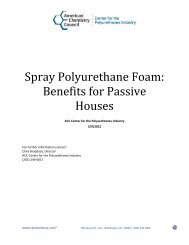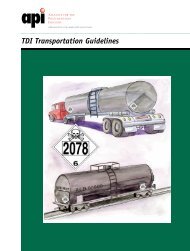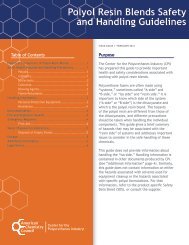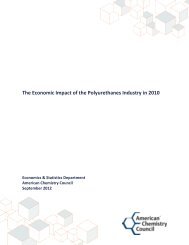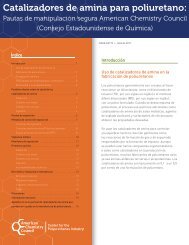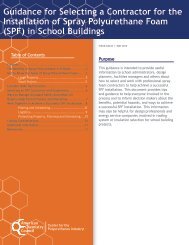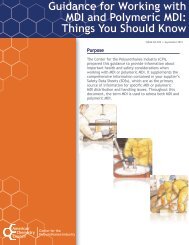MDI Emissions Reporting Guidelines for the ... - Polyurethanes
MDI Emissions Reporting Guidelines for the ... - Polyurethanes
MDI Emissions Reporting Guidelines for the ... - Polyurethanes
You also want an ePaper? Increase the reach of your titles
YUMPU automatically turns print PDFs into web optimized ePapers that Google loves.
<strong>MDI</strong> <strong>Emissions</strong> <strong>Reporting</strong> <strong>Guidelines</strong> <strong>for</strong> <strong>the</strong> <strong>Polyurethanes</strong> Industry<br />
Mw = 250.26 (this is <strong>the</strong> molecular weight of <strong>MDI</strong>)<br />
K<strong>MDI</strong> = adjustment factor to <strong>the</strong> vapor pressure that is a function of <strong>MDI</strong> concentration in <strong>the</strong><br />
feedstock and <strong>the</strong> temperature<br />
359 = <strong>the</strong> molar volume of an ideal gas in ft3 /lb-mole @ 0 o<br />
C and 1-atmosphere<br />
Step I: Calculate Annual Volume of Displaced Air (V air )<br />
Vair = (Area/piece)(No. Pieces/year)(Thickness)<br />
Vair = (350 ft2 )(27 pieces/day)(250 days/yr)(2/12)ft<br />
V air = 3.94 x 10 5 ft 3 /yr<br />
Step II: Calculate Maximum Process Temperature in K<br />
The maximum temperature is <strong>the</strong> oven temperature of 70 o<br />
C or;<br />
T proc = (273.15 + 70 o<br />
C ) K<br />
T proc = 343.15 K<br />
Step III: Determine Vapor Pressure of <strong>MDI</strong> @ 341.15 K (VP <strong>MDI</strong> )<br />
The vapor pressure @ 343.15 K is 1.340 x 10 –3 mm<br />
Step IV: Determine Adjustment factor (K <strong>MDI</strong> )<br />
There<strong>for</strong>e:<br />
9.0 Carpet & Rug Underlay<br />
Adjustment factor @ 343.15 K and 50% <strong>MDI</strong> is 0.61<br />
L c = V air * (1 / 359) * (273.15 / T proc ) * (VP <strong>MDI</strong> / 760) * M w * K <strong>MDI</strong><br />
L c = (3.94 x 10 +5 ft 3 /yr)(1/359)(273.15 K /343.15 K)(1.340 x 10 –3 mm/760) (250.26)(0.61)<br />
L c = 0.2375 lbs/ year<br />
The Carpet and Rug Industry incorporates isocyanate into <strong>the</strong> production process to enhance <strong>the</strong><br />
quality and per<strong>for</strong>mance of <strong>the</strong> final product. The isocyanate feed, consisting of methylenebis<br />
(phenyl Isocyanate) (<strong>MDI</strong>) and polymeric diphenylmethane diisocyanate (P<strong>MDI</strong>), is reacted with a<br />
blend of polyol and inorganic filler. This <strong>for</strong>mulation is continuously applied to <strong>the</strong> carpet substrate<br />
on a moving conveyer belt. Upon curing, <strong>the</strong> polyurethane that is <strong>for</strong>med imparts elasticity, strength,<br />
and resistance to <strong>the</strong> carpet.<br />
5-21


